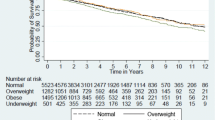Abstract.
Recent studies indicate that pre-transplant (Tx) obesity and increased body mass index (BMI) after renal Tx in adults are associated with decreased long-term renal allograft survival. This study examined whether obesity prior to renal Tx or the development of obesity within the 1st year after Tx in children is associated with worse allograft function at 1 year post Tx. This is a retrospective review of medical records from 76 pediatric renal allograft recipients between January 1994 and December 2000. Recipients had their renal allograft functioning at 1 year, and had a glomerular filtration rate (GFR) measured 1 year post Tx. Obesity was defined as body mass index (BMI)≥95th percentile for age, sex, and race. Patients were divided into three groups: (1) children who had BMI≥95th percentile at time of Tx, (2) children who had BMI<95th percentile at time of Tx but became obese at 1 year after Tx, and (3) children with BMI<95th percentile at time of Tx and 1 year later. The number of patients with BMI≥95th percentile doubled at 1 year after Tx when compared with pre-Tx data: 10 (13%) versus 22 (29%), respectively. Fifteen (20%) patients developed obesity and 10 (13%) patients had BMI between the 85th and 95th percentile at 1 year post Tx. Children in group 1 had significantly lower mean GFR (46.1±15.0 ml/min per 1.73 m2) than children in group 2 (57.7±24.5 ml/min per 1.73 m2, P<0.05) and group 3 (60.4±21.5 ml/min per 1.73 m2, P<0.01). The difference remained significant after adjusting GFR to height: group 1 24.0±5.2 ml/min per m, group 2 31.5±11.2 ml/min per m, P<0.05, and group 3 32.2±10.6 ml/min per m, P<0.01. Children with pre-Tx obesity (group 1) had significantly higher indexed systolic blood pressure (P<0.01) than children from other groups. We conclude that pre-Tx obesity is associated with decreased GFR in children at 1 year after Tx. The reason may be persistence or development of post-Tx hypertension in severely obese patients.
Similar content being viewed by others
Author information
Authors and Affiliations
Additional information
Electronic Publication
Rights and permissions
About this article
Cite this article
Mitsnefes, M.M., Khoury, P. & McEnery, P.T. Body mass index and allograft function in pediatric renal transplantation. Pediatr Nephrol 17, 535–539 (2002). https://doi.org/10.1007/s00467-002-0863-9
Received:
Revised:
Accepted:
Published:
Issue Date:
DOI: https://doi.org/10.1007/s00467-002-0863-9




